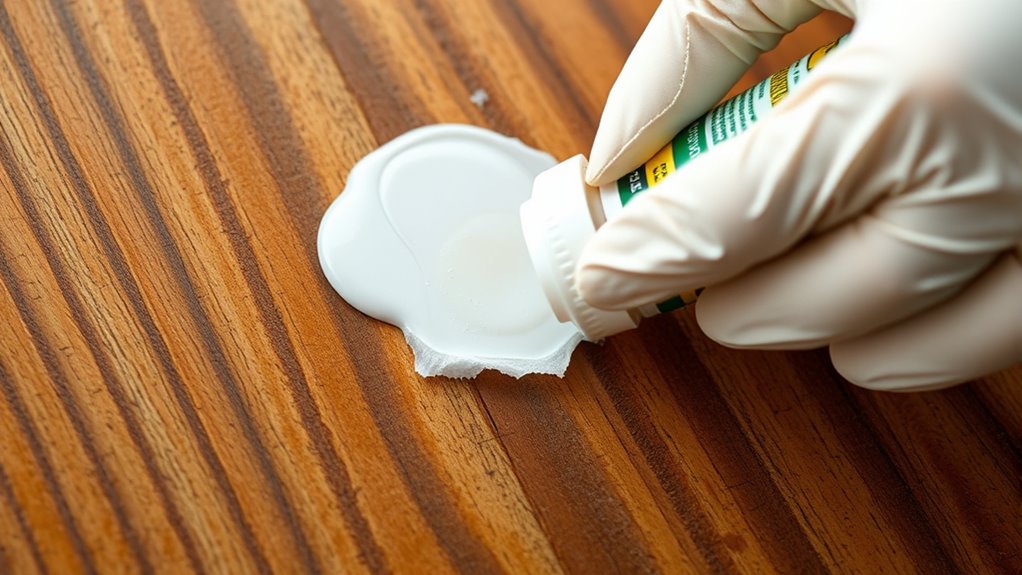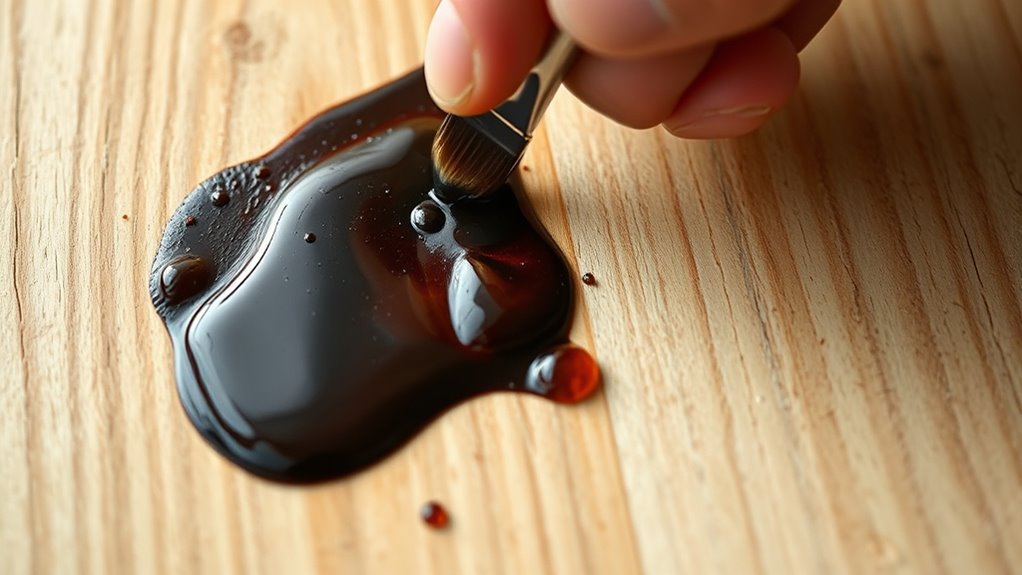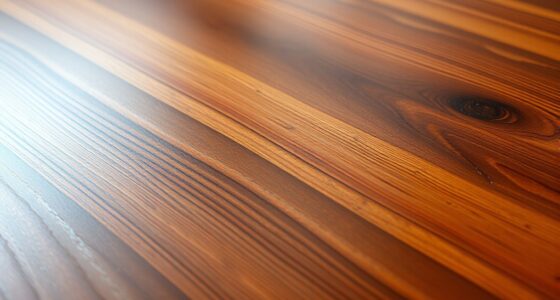To remove old varnish without sanding, you can use chemical paint strippers or a heat gun. Apply a generous coat of a chemical stripper with a brush, wait for it to bubble or soften, then scrape off the loosened finish with a plastic or metal scraper. Alternatively, carefully pass a heat gun over the surface, softening the varnish so you can gently scrape it away. Using these methods can give you a smooth surface, and more tips await if you keep exploring.
Key Takeaways
- Use chemical paint strippers to dissolve varnish without sanding, applying generously and scraping gently after softening.
- Employ a heat gun to soften varnish, then lift it with a scraper, ensuring safety and steady movement to prevent damage.
- Combine chemical stripping and heat application for stubborn finishes, following proper safety precautions for each method.
- Always work in well-ventilated areas, wearing gloves, eye protection, and masks if necessary, to minimize chemical fumes and fumes inhalation.
- Clean the surface thoroughly after removal with mineral spirits or a recommended cleaner before refinishing.

Removing old varnish without sanding is possible with the right techniques and products. If you want to avoid the hassle and dust that sanding creates, chemical strippers and heat guns are your best options. These methods can effectively strip varnish, saving you time and effort while still achieving a smooth surface.
Chemical strippers are a popular choice because they work by breaking down the varnish’s chemical bonds, making it easier to remove. You simply apply a generous coat of the stripper onto the surface using a brush or roller, then wait for it to bubble or soften the finish. Once the varnish has loosened, you can scrape it off with a plastic or metal scraper. Be sure to work in a well-ventilated area and wear gloves and eye protection, as chemical strippers can be harsh and produce fumes. After removing the varnish, clean the surface thoroughly with mineral spirits or a recommended cleaner to eliminate any residue. Follow the manufacturer’s instructions for drying times before applying new finishes. Properly using these methods ensures a safer and more effective removal process.
Heat guns are another effective tool for stripping varnish without sanding. They work by applying controlled heat to soften the varnish, which then becomes easier to peel or scrape away. To use a heat gun safely, hold it a few inches above the surface and move it steadily back and forth to avoid scorching the wood. As the varnish softens, use a putty knife or scraper to lift it off. This method requires caution because excessive heat can damage the wood or cause a fire hazard. Always keep the heat gun moving and avoid concentrating heat in one spot for too long. Once you’ve removed the varnish, wipe the surface with a damp cloth to remove any remaining debris or softened finish.
Both chemical strippers and heat guns are effective alternatives to sanding, but they each have their pros and cons. Chemical strippers are generally easier to control but involve dealing with fumes and cleanup. Heat guns are quick and can be very precise but require careful handling to prevent damage. You might also find that combining both methods works best for stubborn finishes—using a chemical stripper first to loosen the varnish, then a heat gun for final removal. Whichever method you choose, always prioritize safety by working outdoors or in ventilated spaces, wearing protective gear, and following the manufacturer’s instructions. With patience and the right tools, you can successfully remove old varnish without sanding, leaving a clean surface ready for refinishing.
Frequently Asked Questions
Can I Use Chemical Strippers on All Types of Wood?
Yes, you can use chemical strippers on most wood types, but you should consider the wood grain and finish durability. Some woods, like softwoods or delicate veneers, may be damaged by harsh chemicals, so test a small area first. Chemical strippers effectively remove old varnish without sanding, but they can affect the wood’s surface and finish. Always follow manufacturer instructions for best results and to protect the wood.
How Long Does the Chemical Stripping Process Take?
Ever wonder how long chemical stripping takes? Typically, it takes about 15 minutes to several hours, depending on the product and application methods. You should check the drying time specified on the stripper’s instructions to guarantee effective removal. Applying the stripper evenly and allowing it to sit undisturbed helps speed up the process. Rushing it might leave residue, so patience is key for a smooth, clean finish.
Are There Any Health Risks With Chemical Varnish Removers?
Yes, there are health risks with chemical varnish removers due to chemical exposure. You might experience skin irritation, respiratory issues, or eye damage if you don’t take proper precautions. Always work in a well-ventilated area, wear gloves, goggles, and a mask to protect yourself. Reading the label and following safety instructions reduces your risk of adverse health effects while removing varnish safely.
Will Removing Old Varnish Affect the Wood’s Integrity?
Removing old varnish, when done carefully, won’t hurt the wood’s integrity. You’ll want to focus on proper surface preparation to preserve the wood’s strength and appearance. Think of it like giving your furniture a fresh start while maintaining its natural beauty. Using gentle, non-abrasive methods helps protect the wood, ensuring it stays durable and well-preserved after the varnish is removed.
How Do I Dispose of Chemical Stripping Residues Safely?
You should safely dispose of chemical stripping residues by following your local hazardous waste regulations. First, collect the residues in a sealed, labeled container. Never pour chemicals down the drain or onto the ground. Take the container to a designated hazardous waste disposal site or contact your local waste management authority. Proper chemical disposal prevents environmental contamination and health risks, ensuring you’re handling hazardous waste responsibly.
Conclusion
Removing old varnish without sanding is doable and saves you time and effort. With the right techniques, you can breathe new life into your wood surfaces without the mess and hassle of traditional methods. Just remember, patience is key—sometimes, you have to roll with the punches and let the process unfold naturally. Once you see that fresh, smooth finish, you’ll know all your hard work paid off. It’s a win worth every bit of your effort.









